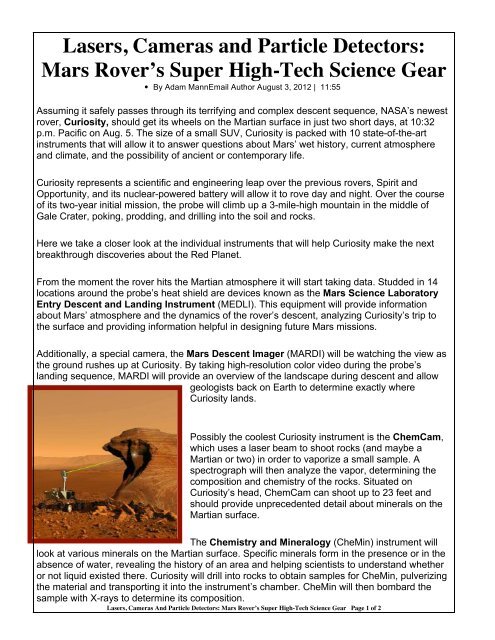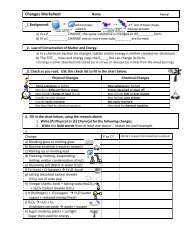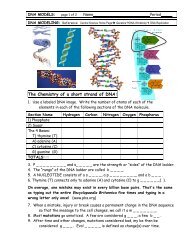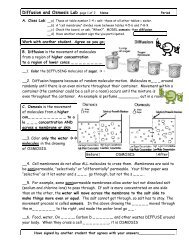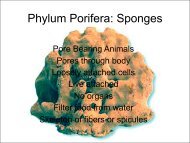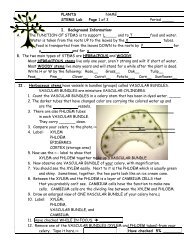Mars Rover Parts
Mars Rover Parts
Mars Rover Parts
You also want an ePaper? Increase the reach of your titles
YUMPU automatically turns print PDFs into web optimized ePapers that Google loves.
Lasers, Cameras and Particle Detectors:<strong>Mars</strong> <strong>Rover</strong>’s Super High-Tech Science Gear• By Adam MannEmail Author August 3, 2012 | 11:55Assuming it safely passes through its terrifying and complex descent sequence, NASA’s newestrover, Curiosity, should get its wheels on the Martian surface in just two short days, at 10:32p.m. Pacific on Aug. 5. The size of a small SUV, Curiosity is packed with 10 state-of-the-artinstruments that will allow it to answer questions about <strong>Mars</strong>’ wet history, current atmosphereand climate, and the possibility of ancient or contemporary life.Curiosity represents a scientific and engineering leap over the previous rovers, Spirit andOpportunity, and its nuclear-powered battery will allow it to rove day and night. Over the courseof its two-year initial mission, the probe will climb up a 3-mile-high mountain in the middle ofGale Crater, poking, prodding, and drilling into the soil and rocks.Here we take a closer look at the individual instruments that will help Curiosity make the nextbreakthrough discoveries about the Red Planet.From the moment the rover hits the Martian atmosphere it will start taking data. Studded in 14locations around the probe’s heat shield are devices known as the <strong>Mars</strong> Science LaboratoryEntry Descent and Landing Instrument (MEDLI). This equipment will provide informationabout <strong>Mars</strong>’ atmosphere and the dynamics of the rover’s descent, analyzing Curiosity’s trip tothe surface and providing information helpful in designing future <strong>Mars</strong> missions.Additionally, a special camera, the <strong>Mars</strong> Descent Imager (MARDI) will be watching the view asthe ground rushes up at Curiosity. By taking high-resolution color video during the probe’slanding sequence, MARDI will provide an overview of the landscape during descent and allowgeologists back on Earth to determine exactly whereCuriosity lands.Possibly the coolest Curiosity instrument is the ChemCam,which uses a laser beam to shoot rocks (and maybe aMartian or two) in order to vaporize a small sample. Aspectrograph will then analyze the vapor, determining thecomposition and chemistry of the rocks. Situated onCuriosity’s head, ChemCam can shoot up to 23 feet andshould provide unprecedented detail about minerals on theMartian surface.The Chemistry and Mineralogy (CheMin) instrument willlook at various minerals on the Martian surface. Specific minerals form in the presence or in theabsence of water, revealing the history of an area and helping scientists to understand whetheror not liquid existed there. Curiosity will drill into rocks to obtain samples for CheMin, pulverizingthe material and transporting it into the instrument’s chamber. CheMin will then bombard thesample with X-rays to determine its composition.Lasers, Cameras And Particle Detectors: <strong>Mars</strong> <strong>Rover</strong>’s Super High-Tech Science Gear Page 1 of 2
The <strong>Rover</strong> Environmental Monitoring Station (REMS) will be Curiosity’s weatherman,providing data about daily atmospheric pressure, wind speed, humidity, ultraviolet radiation, andair temperature. REMS will sit on Curiosity’s neck and also help assess long-term seasonalvariation in <strong>Mars</strong>’ climate.The Alpha Particle X-Ray Spectrometer (APXS) sits the end of Curiosity’s arm, allowing therover to place it right up against rocks and soil. It will then shoot X-rays and alpha particles(essentially Helium nuclei) at the materials to identify how they formed.The Sample Analysis at <strong>Mars</strong> (SAM) is one of the most important instruments and the reasonthat Curiosity can be called a mobile laboratory. Taking up more than half of the rover’s body,SAM contains equipment found in top-notch labs on Earth: a mass spectrometer to separatematerials and identify elements, a gas chromatograph to vaporize soil and rocks and analyzethem, and a laser spectrometer to measure the abundances of certain light elements such ascarbon, oxygen, and nitrogen – chemicals typically associated with life. SAM will also look fororganic compounds and methane, which may indicate life past or present on <strong>Mars</strong>.The other experiment important in Curiosity’s search for Martian habitability is the DynamicAlbedo of Neutrons (DAN) instrument, which will look for water in or under the Martian surface.Water, both liquid and frozen, absorbs neutrons differently than other materials. DAN will be ableto detect layers of water up to six feet below the surface and be sensitive to water content as lowas one-tenth of a percent in Martian minerals.Curiosity has plenty of eyes to take in the view on the ground.Perched atop its head is the MastCam, two cameras capable oftaking color images and video, as well as stitching picturestogether into larger panoramas. One of these two cameras hasa high-resolution lens, allowing Curiosity to study the distantlandscape in detail.The <strong>Mars</strong> Hand Lens Images (MAHLI) instrument will provideclose-up views of rocks and soil samples near the rover. MAHLIsits at the end of Curiosity’s long, flexible arm, and can imagedetails down to about 12.5 micrometers, roughly half thediameter of a human hair. The instrument will also be able tosee in ultraviolet light, which will come in handy during night exploration and funky psychedelicparties.Rounding out Curiosity’s cameras are the hazard-avoidance Hazcams and navigation Navcams.The Hazcams will watch underneath the rover to prevent it from crashing into any large objectswhile the Navcams will be mounted on the rover’s mast to help it steer. Both camera sets will becapable of taking stereoscopic 3D images.Future <strong>Mars</strong> missions may rely on data from the Radiation Assessment Detector (RAD). Thefirst instrument that Curiosity fires up when it lands on <strong>Mars</strong>, RAD will measure radiation at theMartian surface, determining how plausible it is that microbes exist there. One of RAD’s mainselling points is its ability to assess how safe or dangerous the Martian surface would be tofuture human explorers, calculating the radiation dose future astronauts may receive.!Lasers, Cameras And Particle Detectors: <strong>Mars</strong> <strong>Rover</strong>’s Super High-Tech Science Gear Page 2 of 2


